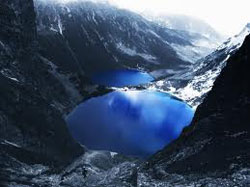Useful comments about meditation practice (II)
by yoga professor Dan Bozaru
Read here the first part of this article
 At first, analysis we do during meditation involves the use of the words, rather like the thoughts that run through our minds regarding a situation, an event or a person, or like when we support inner “monologues” about an opinion or cause we consider important. As we deepen the meditative state, discursiveness begins to be gradually replaced with extensive ideas, which do not necessarily require words to be understood. These ideas are soon the vehicle for states of spirit and knowledge at a high level. This is the stage where we can say that we are approaching the upper layers of the mind, when we are in the area of refined intellect and when the seeds of spiritual intuition appear. It is a phase in which body consciousness, although still present, is not a disturbance. It can even transform into a very pleasant state, of comfort and organic harmony. Also, the mental processes seem to slow and also to “shine”, and our feeling is that we begin to elevate ourselves and look at everything in a kind of global vision. This feeling cannot be imposed mentally and does not represent an act of egotistic will. Instead it is the result of a refinement of consciousness, which also attracts a sensation of extraordinarily large mental dilation. After the minutes which mark this ascension and dilation, there gradually appears a “quietness” in the sense that we seem to “get used” to the new condition we experience. Thus we remain somewhat “suspended”, as if floating somewhere at a great height. We are also conscious that the mental activity has diminished a lot and we are surrounded by silence.
At first, analysis we do during meditation involves the use of the words, rather like the thoughts that run through our minds regarding a situation, an event or a person, or like when we support inner “monologues” about an opinion or cause we consider important. As we deepen the meditative state, discursiveness begins to be gradually replaced with extensive ideas, which do not necessarily require words to be understood. These ideas are soon the vehicle for states of spirit and knowledge at a high level. This is the stage where we can say that we are approaching the upper layers of the mind, when we are in the area of refined intellect and when the seeds of spiritual intuition appear. It is a phase in which body consciousness, although still present, is not a disturbance. It can even transform into a very pleasant state, of comfort and organic harmony. Also, the mental processes seem to slow and also to “shine”, and our feeling is that we begin to elevate ourselves and look at everything in a kind of global vision. This feeling cannot be imposed mentally and does not represent an act of egotistic will. Instead it is the result of a refinement of consciousness, which also attracts a sensation of extraordinarily large mental dilation. After the minutes which mark this ascension and dilation, there gradually appears a “quietness” in the sense that we seem to “get used” to the new condition we experience. Thus we remain somewhat “suspended”, as if floating somewhere at a great height. We are also conscious that the mental activity has diminished a lot and we are surrounded by silence.
Many practitioners wrongly consider then that they have entered the so-called supramental, i.e in a state that transcends the mind, but this is not true. In the period of transition we notice that, even if the condition is very comprehensive, dilated, refined and slightly euphoric, it still clearly retains space-time elements (such as, for example, the sensation of the immense space in which we have dilated or the sensation of the flow of time) or discursive thoughts. The supramental penetration is not only at the declarative level; thus, it is not enough to say or believe, according to our possibilities, that we entered into this very high reality of consciousness. The supramental penetration is marked by a profound state of consciousness, in which most of our ideas and ordinary mental tendencies have disappeared completely; the general sensation is then like “you have forgotten to think”; there is also a sensation of great intensity, though we cannot say clearly what exactly has intensified. The general perception is that the whole field of consciousness has acquired this property of intensity, which in the same time appears as a very great clarity; also, we have the sensation that we can know what we want at any point or in any direction we want, but we discover that when we manifest our will in this way, we immediately descend into mind. We feel this as a heaviness of being and as a state of slight indisposition. This is because penetration into the supramental was still incipient, in other words, we are still fairly close to the area of transition between mental activity and the one in which the normal functioning of the mind is transcended.
 To deepen more and more into the supramental consciousness it is necessary, especially at first, to stay as still as possible at the level of the mind after the transition. We must not do anything, think about anything, act in any way. But we soon realize that we cannot proceed until we become very vigilant, i.e. we must keep ourselves in a state of continuous and very focused attention. This creates the sensation of our focus being a very narrow area, which tends to become a point. Curiously, this apparent “tightening” of our being leads us in fact, simultaneously, to an expansion of being. However, it is different to that extraordinary dilation of the superior mind, which preceded the entry into the supramental. It is more refined and has a new “consciousness”; it is a kind of space, but with more dimensions.
To deepen more and more into the supramental consciousness it is necessary, especially at first, to stay as still as possible at the level of the mind after the transition. We must not do anything, think about anything, act in any way. But we soon realize that we cannot proceed until we become very vigilant, i.e. we must keep ourselves in a state of continuous and very focused attention. This creates the sensation of our focus being a very narrow area, which tends to become a point. Curiously, this apparent “tightening” of our being leads us in fact, simultaneously, to an expansion of being. However, it is different to that extraordinary dilation of the superior mind, which preceded the entry into the supramental. It is more refined and has a new “consciousness”; it is a kind of space, but with more dimensions.
When we reach this “area” of meditation, we are very close to our revealing our divine essential nature, which is the Supreme Self. Revelation itself is not a process, i.e it is not spread on several stages over a period of time; when it occurs, it is instant. But what causes it? How can we influence it? The truth is that it is not determined by anybody anything and, certainly, we cannot influence it in any way..
We thus arrive at an important point of our discussion, which must be understood profoundly. We talk always of “Self-revelation” or that “I have revealed the Self”; but who has revealed what to whom? From the automatic expressions that we often say there always remains an “I” who has revealed something called “Self”. Revelation always has the meaning of showing us what or who we really are, and as we are talking about “Self-revelation”, it comes to the point that we really are the Self. This means that the “I” we say it has “revealed the Self” can only be false. Indeed, it is the ego, i.e the person in the sense of individuality, which is attributed “revelation”. However, the ego is not real, but false; it is a mental construction, designed to mislead us, just like a mirage in the heat of the desert can make us believe that what we see is an oasis with cold water and palm trees, when in reality it is not so. We can say therefore that the ego does not exist, most likely the mirage in the desert does not actually exist.
Then, who reveals the Self? Nobody in particular, other than Himself. In this case, the term “revelation” becomes somehow inappropriate, because in reality it does not reveal anything new to anyone. In its cosmic game, the Self just “is playing” in order to learn something new and for this it assumes the “individual” condition. In this way the idea that “individuality” discovers itself appears, in the sense that it discovers its “origin”. Even this “discovery” of the essential nature requires a certain maturation in time, of a deepening that is done during deep meditation. In itself, self-revelation is that illuminating flash that brings the unshakeable inner conviction that the real “I” is everything that surrounds us and that source of all is “I”. Unfortunately, what happens many times is that this illuminating flash is not enough to be deeply experienced by all those who feel it and especially that its truth is not attentively investigated by those who have experienced it. Thus, the terrible power of illusion, which manifests through the power of ideas of the individuality (thus, the force of the ego) starts to quickly obscure the light of the truth that shined for a split second the being. In time, it may even disappear again.
 During meditation it is important not to create mental differences between “I” (the one who meditates) and the Self which we want to reveal (as our essential nature). The mind is structured to almost automatically associate the idea of “I” with the physical body, with aspirations or with other types of psycho-mental manifestations. This would only introduce in the equation of revelation a disturbing factor, because then we subversively induce the idea that “we will know the Self”. However the mind knows only relatively, i.e to know something there is need of a subject, the knower and an object which is known. On the other hand, the Self is the unique reality and in this situation there is no one to know it and also, there is nothing which can be known. Because of this, our idea of seeking the Self or finally arriving to discover it somewhere, around a corner, is wrong and cannot lead us to a viable result. We cannot know Self as an object, because we ourselves are the very Self. Therefore, our attitude during meditation must soon be that of aiming to identify with our inner nature, the divine, which is the Self, and not of knowing it as new information, separate from ourselves. But how can we do this? The trap exists even here, in the question: who wants to identify with the Self? There is nothing outside the Self, so who is the entity that wants to identify with it? Then we say, if there is no such entity outside the Self, at least we try to stay as immobile as possible, both with the body and mind, because this way it is possible for unification to occur. It is a good piece of advice, but again the question is: Who, with what is unified? Who makes the effort or endeavour to remain immobile?
During meditation it is important not to create mental differences between “I” (the one who meditates) and the Self which we want to reveal (as our essential nature). The mind is structured to almost automatically associate the idea of “I” with the physical body, with aspirations or with other types of psycho-mental manifestations. This would only introduce in the equation of revelation a disturbing factor, because then we subversively induce the idea that “we will know the Self”. However the mind knows only relatively, i.e to know something there is need of a subject, the knower and an object which is known. On the other hand, the Self is the unique reality and in this situation there is no one to know it and also, there is nothing which can be known. Because of this, our idea of seeking the Self or finally arriving to discover it somewhere, around a corner, is wrong and cannot lead us to a viable result. We cannot know Self as an object, because we ourselves are the very Self. Therefore, our attitude during meditation must soon be that of aiming to identify with our inner nature, the divine, which is the Self, and not of knowing it as new information, separate from ourselves. But how can we do this? The trap exists even here, in the question: who wants to identify with the Self? There is nothing outside the Self, so who is the entity that wants to identify with it? Then we say, if there is no such entity outside the Self, at least we try to stay as immobile as possible, both with the body and mind, because this way it is possible for unification to occur. It is a good piece of advice, but again the question is: Who, with what is unified? Who makes the effort or endeavour to remain immobile?
Aware of all this as the subtle idea of individuality, which is different from the Self, it is impregnated in almost every thought or intention which we manifest. Therefore, meditation firstly has the virtue of making us become extremely attentive and vigilant to the thoughts and attitudes we have in meditation. We discover that, although it is clear that we are not the physical body and not thought or mind, there however remains the profound and unchanging sense of our existence. We can suffer the most diverse transformations at all levels, but we cannot say that feeling of existing has transformed. It is still me when I was two and it is still me now; it is not someone else, is the same “I”. We observe that here it is about the pure “I”, which is not associated with something. It is not associated with the body or mind, with name or with fame. It is just about “I am”: pure, untouchable, immutable, unchanging, eternal. It is eternal and unaltered aware of the fact that it exists, and this awareness, which is the same in all sequences of time, space and beyond them is Pure Consciousness itself.
Consciousness is thus the feeling that we are, that we exist. Usually people are not even aware that they exist in this way, purely subjective, but labour under the illusion they tend to associate with their names and exterior form. From here occur all the problems and tribulations of life. In meditation however, we have the opportunity to apply much greater attention to these aspects. We thus understand that we are actually Consciousness, because at the basis of our existence we always find this unalterable “I-am”. On the other hand, I am the Self, because this Self means: I, unique reality. Therefore Consciousness, i.e “I am” is Self and this is Reality.
However, we can say: “Fine, I am Consciousness, but ultimately what is this Consciousness? Is it substantial? It is not seen, not perceived, but still seems like a continuously experiment.” Indeed, after all the above conclusions show that we are nothing in relation to the phenomenal world. We exist as Pure Consciousness and in the same time we do not exist for manifestation. Always when phenomenality appears, the Truth tends to be obscured, and when the Truth comes to light and shines with power, the manifested world disappears. Finally the perfect combination and understanding of these two is possible, but this is a final stage that holds absolute spiritual perfection, which we will refer to another time. The important thing now is to understand how we think that “I am” during meditation?

The reflex tendency is to discover something concrete on which to cling for support in our meditation, as for example, in laya-yoga type meditation we use a mantra, and in other meditations we use an image of the divinity chosen to worship, a name of the Divine or even a symbolic geometric representation (a yantra) of one of the spheres of force and macrocosmic consciousness. Here, however, we go directly to the root of the problem and we even “investigate” the source. The source is “I am” and its reality is valid even in the absolute sense. Nothing can exist if I am not; also, everything exists because I am.
In the context of meditation, the most difficult thing is to be. What does this means? What does it mean just to be? What does “I am” mean? Rather, how to understand this reality? Although the feeling of existence is obvious for all of us (because we cannot say that we do not exist), yet paradoxically this feeling cannot be lived, but instead it seems that we are lived by it. No matter how we try to identify it with something or something else, we cannot achieve this. It appears as empty, nothing, and yet it is perfectly full and without flaw. It is impossible to “identify” ourselves with it, because we are already it. Any desire to know or understand it has no sense, because it has no focal point. “I am” is the supreme subject and the subject can never become an object of observation. Then, yet how can we understand that “I am” profoundly, irrevocably, eternal and perfectly pure? We can only stay in waiting extremely vigilant, however without this involving any tension on our part. Any contraction of this kind or another would automatically mean the idea of another “I”, which can only be false, i.e an infringement of the mind, a wrong attribute of our essential nature. In this approach, vigilance which is translated by an inner peace and an extraordinary clarity, can occur spontaneously, as a real act of grace, the moment of Self-revelation. Its depth cannot be expressed by words and the inner condition that occurs can only be intuited. The fruit is ripe and is immediately picked. Our divinity is then revealed; it remains only to assimilate and expand as deep as possible this truth in the context of the life experience which we live.
At the end of this presentation we aim to briefly analyse an aspect that from ancient times was the subject of a lively and very interesting debate. We refer here to the relationship between the perfect spiritual master and his disciple. Among the multitude of issues which are involved in this relationship we will remain with the one concerning Self-identity. The grace of the spiritual is fundamental in the disciple’s liberation. But the guru is the very self, i.e he is fully awoken and manifested Supreme Consciousness in his physical body. On the other hand, the authentic disciple feels unlimited love and sincere and complete devotion to his master, but he often seems to stop at this level, refusing to understand things further, in their essence. To say, for instance, that between him (the disciple) and his perfect spiritual master there is no fundamental difference is a blasphemy for many. Yet, there is an essential identity between the two, for both the guru and the disciple are, in their nature, Self, i.e Supreme Consciousness. The difference between the liberated master and the disciple is that, while the first one understood and actually achieved what he is in reality, the disciple still firmly believes that he is that what, in fact, does not exist.
The whole process of self-revelation, all the rituals to invoke the spiritual master, any act of worship represents the more or less direct form of causing the consciousness of the disciple to understand that in reality there is not even the slightest difference between him and his master. The one who worships and the one who is worshipped, the one who understands and the one who explains, the one who offers grace and the one who receives it are the same in eternity: The Supreme Self. Both the master and the disciple, as forms in manifestation that live certain experiences and connections over hundreds or thousands of existences are nothing other than the roles the Self plays on the stage of life and which it admires in the same time, in the ecstasy of his own unfathomable mystery.
Source: Yoga Magazin no. 77
yogaesoteric
31 May 2012


